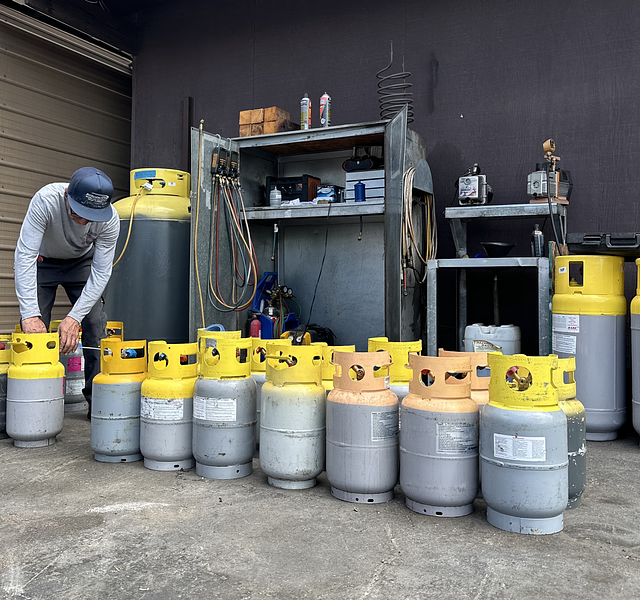If you live in a place where summers are scorching, then you know how much of a lifeline your air conditioner can be. But have you ever thought about what makes that refreshing, cool air possible? Fans, thermostats, and compressors help, but refrigerant is the key. So, what is refrigerant? Well, This essential substance is what allows your air conditioning system to transfer heat and keep your home comfortable, even on the hottest days.
Many homeowners don’t give refrigerants much thought until something goes wrong. Maybe the air conditioner refrigerant isn’t cooling the house like it used to, or perhaps there's a mysterious hissing sound coming from the unit. At that point, questions arise: What exactly is refrigerant? How does it work? And does it need to be replaced?
This guide will answer all these questions and more, so you can better understand the role refrigerant plays in your home’s cooling system—and why it’s so important to keep it in check.
What Is Refrigerant - Does It Help In Air Cooling?
Let’s start with the basics: What is refrigerant? Commonly referred to by the brand name 'Freon', in short, it’s the chemical compound responsible for the cooling process in your air conditioning system. Refrigerant absorbs heat from the air inside your home and releases it outside, allowing the system to produce the cool air that keeps you comfortable.
The magic of refrigerant lies in its ability to change states from liquid to gas and back to liquid. As it circulates through your HVAC system, it evaporates and condenses, moving heat from inside your home to the outdoors. It’s this cycle of evaporation and condensation that powers the entire cooling process.
There are several types of refrigerant for HVAC used in air conditioners, and not all of them are created equal. The refrigerant your system uses depends on its age, environmental considerations, and regulatory standards. In the past, R-22 was the most popular refrigerant. However, due to its harmful environmental impact, R-22 has been phased out in favor of more eco-friendly alternatives like R-410A.
The important takeaway is this: without refrigerant, your air conditioner wouldn’t be able to cool your home, and understanding how it works is key to keeping your system running smoothly.
How Does HVAC Refrigeration Work?
So, how does HVAC refrigeration work in your air conditioning system? Think of refrigerant as the workhorse behind the scenes, quietly circulating through the system and making the magic happen.
The process begins with the compressor, where the refrigerant enters as a low-pressure gas. The compressor’s job is to pressurize the refrigerant, turning it into high-pressure gas. This step significantly increases the temperature of the refrigerant, which is why the next part of the process takes place outside your home.
Once the refrigerant reaches the condenser, it releases the heat it picked up from your home’s indoor air. The condenser, located in the outdoor unit of your air conditioner, cools the refrigerant down and turns it back into a high-pressure liquid. This is where the refrigerant dumps the heat that is absorbed from your home.
The next stop is the expansion valve, which reduces the pressure of the refrigerant, turning it into a low-pressure liquid. At this point, the refrigerant is cold again and ready to start absorbing heat.
Finally, the refrigerant passes through the evaporator coils located inside your home. As it moves through the coils, it absorbs heat from the indoor air, turning into a low-pressure gas once more. The cool air is then blown into your home, and the refrigerant begins its journey all over again. Here’s the breakdown, still wondering what is refrigerant and how it works.
This continuous cycle of heating, cooling, compressing, and expanding is what allows your air conditioner to remove heat from your home and keep you cool all summer long.
AC Refrigerant Cycle: The Heart of Your Cooling System
The refrigerant cycle is the engine behind your air conditioner’s cooling power. If you've ever wondered how exactly your AC cools your home, it all comes down to this cycle. Think of it as a loop that refrigerant follows over and over again to transfer heat from inside your home to the outdoors.
The refrigerant cycle can be broken down into four main stages: compression, condensation, expansion, and evaporation. Here's a deeper dive into each step of the process:
- Compression: The refrigerant enters the compressor as a gas and gets pressurized, which increases both its temperature and pressure. This allows the refrigerant to travel through the system efficiently.
- Condensation: In the condenser, the high-pressure gas releases its heat to the outside air. This process cools the refrigerant and turns it back into a liquid. The heat is expelled from the system, which is why your outdoor AC unit feels warm when it’s running.
- Expansion: As the liquid refrigerant flows through the expansion valve, its pressure drops, causing it to become cold once more. This prepares the refrigerant to absorb heat as it re-enters your home.
- Evaporation: The cold refrigerant travels through the evaporator coils inside your home, absorbing heat from the air. This process cools the indoor air, which is then circulated throughout your home. The refrigerant turns back into a gas, ready to start the cycle again.
Each component of your air conditioning system works together to complete the refrigerant cycle, and the efficiency of this process is what determines how well your home is cooled.
The Importance of Refrigerant
When people think about what makes their air conditioner work, they often focus on the thermostat or the fan, but the true hero of the story is the refrigerant. Without it, your air conditioner wouldn’t be able to do its job, and your home would be left sweltering in the summer heat.
Refrigerant plays a crucial role in transferring heat. It absorbs heat from inside your home and expels it outside, allowing your air conditioner to keep the indoor environment cool and comfortable. If there’s not enough refrigerant in the system—or if the refrigerant leaks—your AC won’t be able to effectively cool your home. This can lead to higher energy bills, longer run times, and a system that struggles to keep up with the temperature demands.
It’s also important to note that refrigerant doesn’t just “run out” like gas in a car. If your system is low on refrigerant, it usually means there’s a leak that needs to be repaired. Continuing to operate your AC with low refrigerant can damage other components in the system, such as the compressor, and lead to costly central AC repairs down the road.
Refrigerant is the lifeblood of your air conditioner, and keeping it at the proper level is essential to both your comfort and the longevity of your HVAC system.
Different Home Air Conditioner Refrigerant Types Compared
Not all refrigerants are created equal. Over the years, the HVAC industry has evolved, moving from environmentally harmful refrigerants to more eco-friendly alternatives. Here’s a closer look at the what is refrigerant’s main type & how it compares with other types:
- R-22: R-22 was once the standard refrigerant used in most air conditioning systems. However, it has been phased out due to its ozone-depleting properties. If your AC was installed before 2010, it might still use R-22, but refilling it can be expensive as it’s no longer produced.
- R-410A: This is the most commonly used refrigerant in newer air conditioning systems. It’s much better for the environment because it doesn’t contain chlorine, which harms the ozone layer. Newer, updated equipment using R-410A is also more energy-efficient, offering better cooling performance while using less electricity.
- R-454B: This refrigerant is set to replace R-410A in future, more energy-efficient air conditioning systems due to its reduced environmental impact. It has a lower GWP, making it an even more eco-friendly option.
- R-32: As a newer refrigerant, R-32 is gaining popularity for its lower Global Warming Potential (GWP). It’s designed to replace R-410A in modern energy-efficient systems, making it a greener option for cooling homes.
- R-134a: While not commonly used in home air conditioners, R-134a is found in refrigeration systems and automotive air conditioning. It doesn’t deplete the ozone layer and is considered a better alternative to older refrigerants.
Understanding the type of refrigerant your system uses is important, especially when it comes to repairs or replacements. If you’re thinking about upgrading your AC, it’s worth considering the type of refrigerant the new system will use, as this can impact both performance and environmental impact.
Does AC Refrigerant Need to Be Refilled & How to Check?
What is refrigerant’s limitation? One of the biggest misconceptions about air conditioners is that refrigerant needs to be “topped off” regularly. The truth is, that refrigerant is part of a closed-loop system, meaning it shouldn’t need to be refilled unless there’s a leak.
But leaks happen. When they do, they can cause several issues, from poor cooling performance to higher energy bills. Here are a few signs that your AC might be low on refrigerant:
- Warm air from vents: If the air coming from your vents feels warmer than usual, it could indicate low refrigerant levels.
- Ice buildup: When refrigerant levels drop, it can cause the evaporator coils to freeze. If you notice ice on the coils or refrigerant lines, there’s a good chance your system is leaking refrigerant.
- Hissing or bubbling sounds: These sounds are often a sign that refrigerant is leaking from the system.
- Higher energy bills: If your AC is running longer than usual but still isn’t cooling your home effectively, low refrigerant could be the culprit.
What is refrigerant’s main purpose? Well, it may not be something homeowners think about often, but it’s an essential component of any air conditioning system. Understanding how it works and why it’s important can help you keep your HVAC system running efficiently and ensure your home stays comfortable year-round. If you suspect your refrigerant levels are low or you’re experiencing issues with your AC, don’t wait for the problem to get worse. Contact Burgeson’s today for expert HVAC service.
Our licensed technicians can help diagnose refrigerant issues, repair leaks, and ensure your system is running at peak performance. With over four generations of experience, you can trust Burgeson’s to keep your home cool, comfortable, and energy-efficient.
FAQs About Refrigerant
How many pounds of refrigerant do HVAC systems hold?
The amount of refrigerant in an HVAC system varies depending on the size and type of the unit, but most systems hold anywhere from 5 to 15 pounds of refrigerant. Larger commercial units can hold significantly more.
How much does refrigerant cost?
The cost of refrigerant depends on the type and the quantity needed. As of now, R-22 can be quite expensive due to its phase-out. Newer refrigerant like R-410A is currently more affordable, but will also become more costly as the phase-out process begins.
How do you add refrigerant to an AC unit?
Adding refrigerant should only be done by a licensed HVAC technician. They will first locate any leaks, repair them, and then recharge the system with the correct amount and type of refrigerant.












